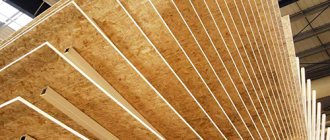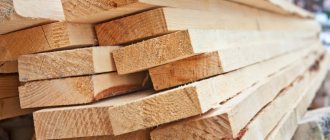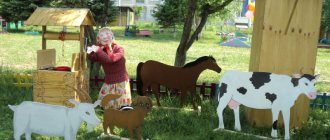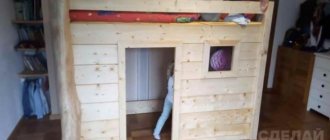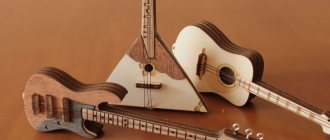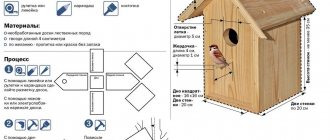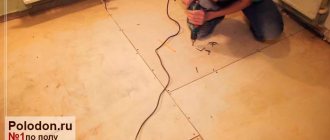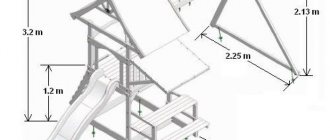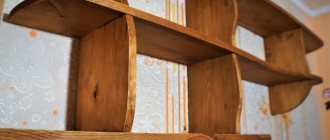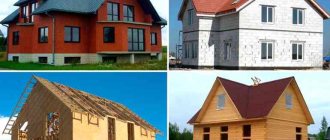Construction of houses is a responsible matter for every family. You need to think in advance about what to build a house from; the construction time and the costs of building housing depend on this. Today we will not discuss construction with ordinary bricks; we will consider the three most popular types of building materials after brick, log house, blocks and vulture panels.
Log houses
Dwellings have been built with logs since ancient times; they also remain a popular material now. Log houses have good heat resistance in winter and coolness in hot weather, environmental friendliness, and sound insulation.
Disadvantages: flammability, shrinkage, various types of destruction by external environmental factors, for this it needs to be treated every year from rotting and various kinds of rodents. The cost of log house housing will be 18,000 - 80,000 per m2, depending on the type of wood.
Types of plywood by area of application
| Kinds | Purpose | |
| Ship - bakelite - FBS | high reliability, strength, moisture resistance, no deformation; used in shipbuilding | |
| Furniture - birch - FC | environmentally friendly, with a pleasant appearance; furniture is made from it, including for children's educational and medical institutions | |
| Construction | light, durable, with heat/sound insulation properties, cheap; used for the manufacture of stretch ceiling frames, decking, partitions | |
| Aviation – FSF | high density, durable, moisture resistant; used in shipbuilding, aircraft manufacturing, carriage building, automobile industry | |
| Formwork – laminated birch – FB | exceptionally durable, resistant to moisture and deformation, lamination greatly increases density and flexural rigidity; wear-resistant and economical | |
| Transport - laminated (mesh-ribbed) - FSF | durable, moisture-resistant, wear-resistant, easy to install; manufacture parts (upholstery of metal frames, doors, flooring) of trucks | |
| Decorative - FC plywood | FC birch plywood can be veneered with any valuable wood, and it is also safe for health, which is why we chose it to make stunningly beautiful wooden cards! | |
Blocks
There are many different types of blocks. The most common foam blocks and gas blocks. Gas blocks and foam blocks have gained great popularity in the construction of private houses in a short time. They have a number of advantages, good heat resistance, sound insulation, lightweight in size compared to other materials, due to this, lower costs for the foundation. Disadvantages: quite fragile, they need to be lined as they quickly absorb moisture due to their porous structure. The cost of a house made of foam blocks will be 11,000 - 20,000 rubles. m2.
Marking
Like any building material, plywood sheets differ in many respects, therefore, for the convenience of their selection, a code with the main characteristics is applied to the products. The marking of plywood and its explanation are given below.
Brand
This parameter reveals the degree of water resistance and some features of the composition:
- FBA is a product with low moisture resistance based on natural adhesives and pure wood without impregnations or additives;
- FC - plywood based on carbamide glue, used only for interior decoration, has an average degree of moisture resistance;
- FSF - sheets with a high degree of moisture resistance are suitable for use indoors and on the facade side on the street. The veneer is glued together with a composition based on phenol-formaldehyde resins;
- FB is bakelite plywood, that is, each layer is impregnated with bakelite varnish. This composition enhances moisture resistance, fixes the result with phenol-formaldehyde-based glue;
- FOF is a product based on FSF, coated on both sides with a laminated film;
- BS - sheets impregnated with alcohol-soluble glue, which gives the wood elasticity;
- BV – impregnation of layers with water-soluble glue. Plywood is waterproof, like BS.
Plywood varieties
The grade of plywood sheets refers to the quality of the external veneer:
- First grade (Ⅰ) – smooth surface with a uniform pattern without knots, no more than 2 hearths per 1 m2 are allowed;
- The second grade (Ⅱ) differs from the highest grade by allowing the use of patches in place of knots;
- The third grade (Ⅲ) are blanks that have not been sorted into grade 2. On them, uneven color of the patches and poor-quality veneer processing are allowed. Such products are used for hidden structures and auxiliary materials (formwork);
- Fourth grade (Ⅳ) – low quality products, defective. Characteristic features include fallen knots, uneven processing and missing layers.
Surface treatment method
The marking must contain the processing code for the front layers:
- NSh – unpolished with a rough surface;
- Ш1 and Ш2 – polished on one or both sides.
For decorative sheets, additional designations are used:
- DF-1 is lined with film on
- DF-3 is lined with decorative paper.
Manufacturers and their costs
Manufacturers in Russia
, the Vyatsky Plywood Mill produces FSF plywood . Its specificity is the production of environmentally friendly material, for which they use birch veneer as a raw material. The company produces a product with the following dimensions: 1220x2440, 1250x2500, 1500x3000, 1525x3050 mm. E1 class glue is used for gluing sheets.
To produce products, the plant uses raw materials of legal origin and the highest quality. During all production activities, all measures are taken to preserve forest biological diversity. You can purchase the product for 850 rubles per sheet.
What thickness of plywood is needed for the floor can be read here in this article.
The next enterprise is considered . They also produce high quality FSF plywood from environmentally friendly wood. Production may include the production of laminated, moisture-resistant plywood. The cost of production will be 960 rubles.
Foreign production
But the production of such products is also actively carried out abroad. Finnish products are in great demand today. The leading position is occupied by the company WISA Birch . To obtain FSF plywood, birch veneer is used. This product has found its use in cases where greater loads are required. Softwood plywood is also produced. This product is characterized by light weight, as well as economic efficiency, which has made it possible to gain such popularity in the field of construction. You can buy the product for 1250 rubles.
FSF plywood is a material that is often used today in industrial construction, as well as in home improvement. This product can be used for cladding the external and internal walls of a house, as well as in rooms where there is high humidity. Thanks to its long service life, FSF plywood will delight you with its quality for a long time. And also in our article you can familiarize yourself with what MDF is.
The difference between FC plywood and FSF
For the production of FC plywood, urea resins are used, in particular urea-formaldehyde resin. The manufacturing technology is somewhat similar to that described above, but there are some differences.
The most important aspect is the urea polymer itself, which will fill and hold the veneer sheets together.
It has objective disadvantages:
- Fragility;
- Low water resistance;
- Poor resistance to destructive influences;
- Release of formaldehyde.
These defects are combated and various reagents are introduced into the reaction mass, but the negative characteristics are not eliminated, but only diminished.
FSF plywood is also expected to release free phenol. But after the polymerization reaction, phenol is present in the material only in trace amounts, and it can only be detected in laboratory conditions.
Other comparative characteristics can be found in the table:
| FSF | FC | |
| Water resistance | Exceptionally high | Weak |
| Strength | In any test, the performance is 80-130% higher than that of FC | Inferior to FSF |
| Biosecurity | Maximum, can be damaged by rodents | Without additional processing it is very weak. |
| Environmental friendliness | Detection of traces of phenol possible | Capable of releasing free formaldehyde |
| Appearance | With the same quality, they are practically no different. The difference can only be seen in the cut. | |
But by external signs it is also possible to distinguish FSF plywood from FC. In order to 100% guarantee to separate one type of material from another, you need to carefully examine the end.
In FSF plywood, phenol-formaldehyde resin after polymerization gives the layers a red-brownish tint. And FC plywood, being treated with urea-formaldehyde resins, has end layers of a yellowish tint.
FIG 1. End of FSF plywood
FIG 2. End face of FC plywood
The depth and saturation of the color depends on the presence of certain reagents, but the tonality will help to identify the material.
Classification according to the composition of the adhesive impregnation
Technical characteristics, sanitary safety, directions of use are largely determined by the composition of the means used to glue the veneer sheets.
Plywood is a long-known material, for the production of which both historically established gluing technologies and innovative methods and composites are used. In addition to traditional types, decorative plywood is produced using expensive types of wood or paper with a texture pattern. According to the method and material of gluing layers, five main groups and several subgroups can be distinguished.
FBA
FBA products have the safest adhesive impregnation, consisting of two protein fractions:
- albumin;
- casein
The environmental friendliness of plywood comes with insufficient water resistance, because protein substances tend to swell in the presence of water. Sheet products are not recommended for use in rooms containing damp vapors; they can be used for the production of furniture and the manufacture of decorative elements for finishing dry rooms.
FC
Products with the abbreviation FC in the marking are produced by joining veneer with urea adhesives that do not emit harmful fumes into the surrounding space. The material is relatively resistant to moisture and can be used for finishing rooms with moderate concentrations of water vapor.
FKM
The products of this group demonstrate good resistance to moisture and have confirmed their absolute safety for the surrounding air. The melamine adhesive with which the veneer is joined is non-reactive and does not become a source of harmful fumes, which makes it possible to use FCM products for interior decoration of any premises and furniture manufacturing.
FSF
Plywood with the FSF designation has increased resistance to moisture, which is due to the use of phenol-formaldehyde resinous polymers for gluing sheets. The glue may contain a residual amount of monomeric aldehyde, which evaporates during use of the material. The regulations allow the use of FSF sheets of different sizes for exterior finishing and the production of street furniture.
Dimensions and thickness of plywood
The dimensions and thickness of plywood are regulated by GOST 3916.2-96 (for coniferous panels) and GOST 3916.1-96 (for hardwood grades). At the same time, the standard sheet width is 1220 mm; plywood 1525 mm wide is also often used. The length of plywood varies from 1525 mm to 2500 mm. Standard sheet size: 2440x1220 mm, and the most popular size: 1525x1525 mm.
The thickness of plywood depends on the raw material and the number of veneer layers (from 3 to 21) and ranges from 3-30 mm.
Plywood varieties
For proper use, it is important to know the grade of the material. Glued veneer sheets are divided into several varieties:
- E (Elite). Old designation - A. High quality version with no flaws on the front surface, minor random deviations may occur. The sheets are used for decorative work and the manufacture of luxury furniture. They are the best base for film cladding and varnishing.
- I grade. Outdated markings are “AB” and “B”. A high-quality variety with a minimum number of defects in the form of cracks up to 2 cm in size per meter of width and visually noticeable fused knots. Wormholes (no more than three per 1 m2) should not exceed 6 mm. The color of the slab is uniform, with possible deviations of about 15%.
- II grade. Previously designated "B" and "BB". Unlike the previous version, it has more flaws. But the surface may contain large fused light and dark knots (up to 15 mm) in the amount of 10 pieces. per 1 m2. Open cracks must be sealed with putty. There may be a lack of veneer (about 2 mm) at the edges.
- III grade. The old markings are “BB” and “SR”. The presence of falling out and large spliced knots, dents, scallops, and torn fibers is allowed (no more than 5% of the area).
- IV grade. Previously designated "C". The product has various and numerous defects, as can be seen in the photo below. The use of such plates is limited to rough work. Despite the shortcomings, the layers are glued together quite well.
Sheets of the highest, first and second grade can be used almost everywhere, the characteristics of grade 3 are also quite high, but the shirt has a small number of defects, and grade 4 is intended exclusively for technical needs
. The sides of the panel may have different quality:
- Grade 1/1. The products have uniform indicators that are precisely specified in GOST 3916.1-96.
- 1/2. The products combine the characteristics of two categories.
- 2/2 and 3/3. The materials fully comply with the second and third quality groups.
- 2/4. One side is second grade, the other is fourth.
Some manufacturers indicate group 5/5, this designation means products for rough construction work.
Surface treatment methods
Let’s complete our story on the topic of how moisture-resistant plywood is labeled with an overview of the classification by type of surface treatment. The cheapest option is unsanded sheets (NS). You can always process them yourself if you have basic tools. Polished products are divided into single- and double-sided (Sh-1 and Sh-2, respectively).
DF-1 plywood has increased moisture resistance, the surface of which is protected with a melamine-formaldehyde film. A similar coating is present in DF-3 sheets, but in addition to it, the outer layers of veneer are treated with decorative paper. Thus, these products boast both high water resistance and excellent appearance.
When studying the markings of laminated plywood, pay attention to the grade. The material must be made of E1 birch. Products of the third grade may have significant bald spots in the coating, not to mention wood defects. High-quality laminate is only the first grade. You can purchase waterproof plywood in Moscow from the manufacturer in our company.
Peculiarities
There are many options for this material, they all differ in their width, coating and manufacturing features.
In order to choose the optimal product, you need to pay close attention to studying the characteristics. Plywood is a regular sheet that is created using wood
In turn, it goes through several stages of processing, which gives the product its unique properties.
The process of gluing the layers occurs through the use of special compounds, which are usually based on resins. The result is a lightweight material that can also boast of its resistance to temperature changes.
Among the main advantages of such a product are the following.
- Resistance to moisture, so the material can even be used for finishing a bathroom. This can be achieved due to the fact that when in contact with water, the plywood sheets do not delaminate and do not lose their shape.
- Ease of processing and installation. This material is famous for its strength, so you can use any processing tools without fear. Plywood can be cut, sawed or drilled without any problems, which makes it stand out from other materials.
- Possibility to combine with other materials. It should be noted that laminated plywood is very often used as an additional material, so it is perfect for finishing a ceiling, floor or roof. Most experts use this plywood in combination with natural wood.
- Huge scope of application. Laminated plywood can boast of its unique performance characteristics, which allows it to be used in the process of finishing work, in the production of furniture and decorations.
A distinctive feature of moisture-resistant laminated plywood is that during the manufacturing process it is processed much longer and is also covered with thicker paper. This paper is impregnated with a special composition, which makes the finished product durable and allows it not to lose its properties for a long time. In addition, it provides resistance to water.
Laminated plywood differs from other materials in that it is almost insensitive to temperature changes, so it can even be used in a bathhouse. The special layer also protects against the effects of cleaning agents, including aggressive abrasives. Another feature of this plywood is that it contains a minimal amount of phenol. This results in a more elastic and durable material, which also has a varnished protective layer of polymer.
